Cell influx and contractile actomyosin force drive mammary bud growth and invagination
- PMID: 34042944
- PMCID: PMC8164091
- DOI: 10.1083/jcb.202008062
Cell influx and contractile actomyosin force drive mammary bud growth and invagination
Abstract
The mammary gland develops from the surface ectoderm during embryogenesis and proceeds through morphological phases defined as placode, hillock, bud, and bulb stages followed by branching morphogenesis. During this early morphogenesis, the mammary bud undergoes an invagination process where the thickened bud initially protrudes above the surface epithelium and then transforms to a bulb and sinks into the underlying mesenchyme. The signaling pathways regulating the early morphogenetic steps have been identified to some extent, but the underlying cellular mechanisms remain ill defined. Here, we use 3D and 4D confocal microscopy to show that the early growth of the mammary rudiment is accomplished by migration-driven cell influx, with minor contributions of cell hypertrophy and proliferation. We delineate a hitherto undescribed invagination mechanism driven by thin, elongated keratinocytes-ring cells-that form a contractile rim around the mammary bud and likely exert force via the actomyosin network. Furthermore, we show that conditional deletion of nonmuscle myosin IIA (NMIIA) impairs invagination, resulting in abnormal mammary bud shape.
© 2021 Trela et al.
Figures



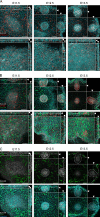



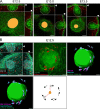

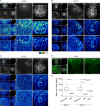


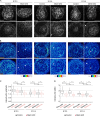
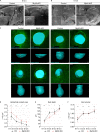
Similar articles
-
Embryonic Mammary Gland Morphogenesis.Adv Exp Med Biol. 2025;1464:9-27. doi: 10.1007/978-3-031-70875-6_2. Adv Exp Med Biol. 2025. PMID: 39821018 Review.
-
Dynamic expression of Erbb pathway members during early mammary gland morphogenesis.J Invest Dermatol. 2008 Apr;128(4):1009-21. doi: 10.1038/sj.jid.5701118. Epub 2007 Oct 25. J Invest Dermatol. 2008. PMID: 17960183
-
A three-dimensional vertex model forDrosophilasalivary gland invagination.Phys Biol. 2021 May 28;18(4). doi: 10.1088/1478-3975/abfa69. Phys Biol. 2021. PMID: 33882465
-
The mammary bud as a skin appendage: unique and shared aspects of development.J Mammary Gland Biol Neoplasia. 2006 Oct;11(3-4):187-203. doi: 10.1007/s10911-006-9029-x. J Mammary Gland Biol Neoplasia. 2006. PMID: 17111222 Review.
-
Cdc42 overexpression induces hyperbranching in the developing mammary gland by enhancing cell migration.Breast Cancer Res. 2013;15(5):R91. doi: 10.1186/bcr3487. Breast Cancer Res. 2013. PMID: 24074261 Free PMC article.
Cited by
-
Moving through a changing world: Single cell migration in 2D vs. 3D.Front Cell Dev Biol. 2022 Dec 20;10:1080995. doi: 10.3389/fcell.2022.1080995. eCollection 2022. Front Cell Dev Biol. 2022. PMID: 36605722 Free PMC article. Review.
-
Mesenchyme instructs growth while epithelium directs branching in the mouse mammary gland.Elife. 2024 Mar 5;13:e93326. doi: 10.7554/eLife.93326. Elife. 2024. PMID: 38441552 Free PMC article.
-
Radially patterned morphogenesis of murine hair follicle placodes ensures robust epithelial budding.Dev Cell. 2024 Dec 16;59(24):3272-3289.e5. doi: 10.1016/j.devcel.2024.09.022. Epub 2024 Oct 15. Dev Cell. 2024. PMID: 39413781
-
Patterning and folding of intestinal villi by active mesenchymal dewetting.bioRxiv [Preprint]. 2023 Aug 15:2023.06.25.546328. doi: 10.1101/2023.06.25.546328. bioRxiv. 2023. Update in: Cell. 2024 Jun 6;187(12):3072-3089.e20. doi: 10.1016/j.cell.2024.04.039. PMID: 37425793 Free PMC article. Updated. Preprint.
-
Myosin II mediates Shh signals to shape dental epithelia via control of cell adhesion and movement.PLoS Genet. 2024 Jun 10;20(6):e1011326. doi: 10.1371/journal.pgen.1011326. eCollection 2024 Jun. PLoS Genet. 2024. PMID: 38857279 Free PMC article.
References
-
- Agostinelli, C., and Lund U.. 2017. R package ‘circular’: Circular Statistics (version 0.4-93). https://r-forge.r-project.org/projects/circular/ (accessed March 13, 2021)
-
- Andl, T., Ahn K., Kairo A., Chu E.Y., Wine-Lee L., Reddy S.T., Croft N.J., Cebra-Thomas J.A., Metzger D., Chambon P., et al. . 2004. Epithelial Bmpr1a regulates differentiation and proliferation in postnatal hair follicles and is essential for tooth development. Development. 131:2257–2268. 10.1242/dev.01125 - DOI - PubMed
Publication types
MeSH terms
Substances
LinkOut - more resources
Full Text Sources
Other Literature Sources
Molecular Biology Databases

